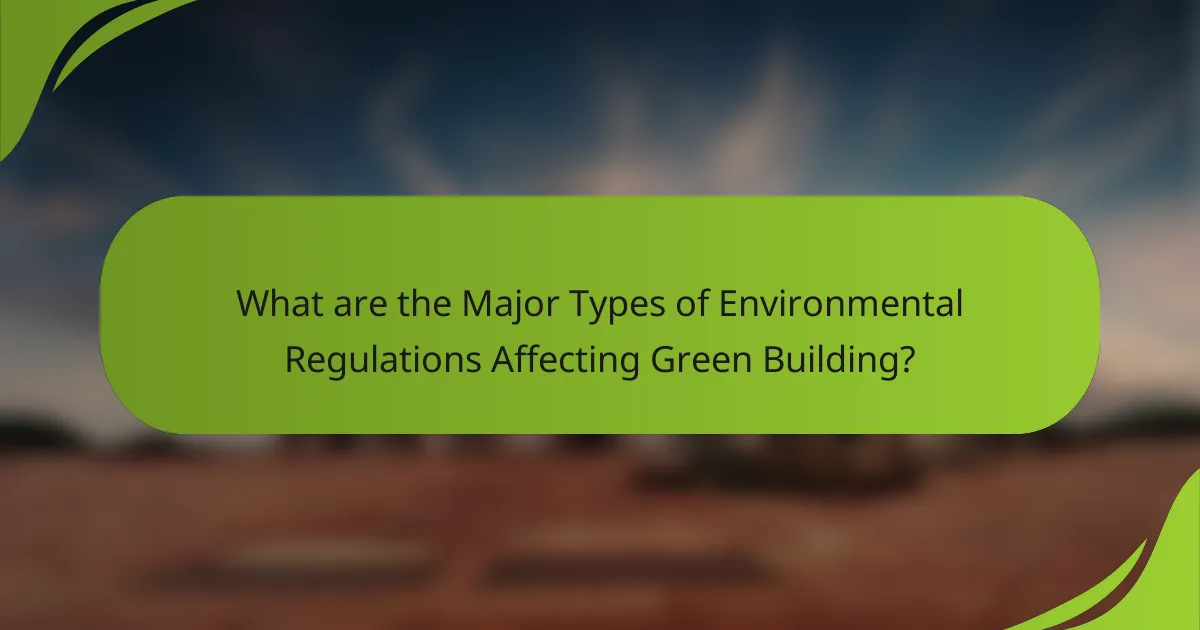Environmental regulations are rules established by governments to safeguard the environment, impacting various aspects of construction, including energy efficiency, waste management, and material usage. These regulations are critical for promoting sustainable building practices and minimizing ecological footprints. Key types of regulations include zoning laws, building codes, and environmental impact assessments, which guide builders in achieving compliance and enhancing resource conservation. Engaging with environmental consultants and utilizing technology for tracking regulatory changes can aid builders in navigating compliance challenges effectively. The article explores the significance of adhering to these regulations in the context of green building practices and their role in fostering sustainable development.

What are Environmental Regulations and Their Importance in Green Building Practices?
Environmental regulations are rules and standards set by governments to protect the environment. They govern various aspects of building practices, including energy efficiency, waste management, and material usage. These regulations ensure that construction projects minimize their environmental footprint. Compliance with environmental regulations is crucial for green building practices. It promotes sustainable development and reduces negative impacts on ecosystems. For instance, the U.S. Green Building Council’s LEED certification program aligns with these regulations. This certification encourages energy-efficient designs and sustainable materials. By adhering to environmental regulations, builders can enhance resource conservation and improve public health.
How do Environmental Regulations influence the construction industry?
Environmental regulations significantly influence the construction industry by imposing standards that govern environmental impact. These regulations require construction projects to minimize pollution and conserve natural resources. Compliance often leads to increased costs due to the need for sustainable materials and practices. For example, the U.S. Green Building Council’s LEED certification encourages eco-friendly building designs. Projects that meet these standards can benefit from tax incentives and increased marketability. Additionally, regulations promote innovation in sustainable construction technologies. Studies show that adherence to environmental regulations can lead to long-term cost savings through energy efficiency. Overall, these regulations shape industry practices and drive the shift towards sustainable construction.
What are the key components of Environmental Regulations?
Key components of Environmental Regulations include standards, permits, and enforcement mechanisms. Standards define acceptable limits for pollutants and environmental impacts. Permits regulate activities that may affect the environment, ensuring compliance with established standards. Enforcement mechanisms involve monitoring and penalties for non-compliance. These components work together to protect natural resources and public health. For example, the Clean Air Act sets specific air quality standards to control emissions. The Environmental Protection Agency (EPA) oversees these regulations, ensuring businesses adhere to legal requirements.
How do these components impact green building practices?
Components such as materials, energy efficiency, and water conservation significantly impact green building practices. These elements help reduce environmental footprints. Sustainable materials minimize resource depletion and pollution. Energy-efficient systems lower energy consumption and greenhouse gas emissions. Water conservation techniques reduce water waste and promote sustainability. Together, these components enhance overall building performance and occupant health. Compliance with environmental regulations often necessitates the integration of these components. For instance, the U.S. Green Building Council’s LEED certification requires adherence to specific sustainable practices. This demonstrates how regulations drive the adoption of green components in construction.
Why is Compliance with Environmental Regulations essential for green buildings?
Compliance with environmental regulations is essential for green buildings because it ensures sustainable practices and minimizes ecological impact. Green buildings aim to reduce resource consumption and enhance energy efficiency. Adhering to regulations helps achieve these goals by promoting the use of environmentally friendly materials and technologies.
Moreover, compliance fosters public trust and enhances the reputation of builders and developers. It can also lead to financial incentives, such as tax breaks and grants, for projects that meet or exceed regulatory standards. According to the U.S. Green Building Council, buildings that comply with standards like LEED (Leadership in Energy and Environmental Design) consume 25% less energy and generate 34% lower greenhouse gas emissions. Therefore, compliance not only aligns with environmental goals but also supports economic benefits for stakeholders involved in green building projects.
What risks are associated with non-compliance?
Non-compliance with environmental regulations can lead to significant legal and financial risks. Organizations may face hefty fines that can reach millions of dollars. Legal action can result from violations, leading to costly litigation. Non-compliance can damage a company’s reputation, affecting customer trust and brand loyalty. It may also result in project delays due to legal disputes or the need for remediation. Additionally, companies may lose eligibility for permits and government contracts. According to a report by the Environmental Protection Agency, businesses that fail to comply with regulations often incur costs that exceed the initial investment in compliance measures. These risks underscore the importance of adhering to environmental regulations in green building practices.
How can compliance enhance sustainability in construction?
Compliance enhances sustainability in construction by ensuring adherence to environmental regulations. These regulations promote the use of sustainable materials and practices. For instance, compliance with the LEED certification encourages energy-efficient designs. It also mandates waste reduction measures during construction. Following these guidelines can lead to lower carbon footprints. Research shows that compliant projects can reduce resource consumption by up to 30%. Additionally, compliance fosters innovation in green technologies. This includes the use of renewable energy sources. Overall, compliance drives the construction industry towards more sustainable practices.

What are the Major Types of Environmental Regulations Affecting Green Building?
Major types of environmental regulations affecting green building include zoning laws, building codes, and environmental impact assessments. Zoning laws dictate land use and building density, influencing site selection for green buildings. Building codes set standards for construction practices, energy efficiency, and sustainability features. Environmental impact assessments evaluate potential environmental effects before project approval. These regulations ensure compliance with sustainability goals and promote environmentally responsible construction practices. Compliance with these regulations can enhance building performance and reduce ecological footprints.
How do federal, state, and local regulations differ in their impact?
Federal, state, and local regulations differ significantly in their impact on environmental compliance. Federal regulations establish baseline standards applicable nationwide, such as the Clean Air Act. These regulations create a uniform framework that all states must follow. State regulations can be more stringent than federal laws, addressing specific regional environmental issues. For example, California has stricter emissions standards than federal guidelines. Local regulations often focus on community-specific concerns, such as zoning laws and building codes. These local laws can vary widely even within the same state. The interaction between these levels of regulation can lead to complexities in compliance for green building practices. Understanding these differences is crucial for developers and builders to navigate the regulatory landscape effectively.
What specific regulations are enforced at the federal level?
The specific regulations enforced at the federal level include the Clean Air Act and the Clean Water Act. The Clean Air Act regulates air emissions from stationary and mobile sources. It sets national ambient air quality standards to protect public health and the environment. The Clean Water Act governs the discharge of pollutants into U.S. waters. It aims to restore and maintain the integrity of the nation’s waters. Additionally, the National Environmental Policy Act requires federal agencies to assess environmental impacts before making decisions. These regulations are essential for promoting sustainable practices in green building. They ensure compliance with environmental standards and protect natural resources.
How do state regulations vary across different regions?
State regulations vary widely across different regions in terms of environmental compliance for green building practices. Each state has its own set of laws and guidelines that dictate construction standards. For instance, California has stringent energy efficiency requirements, while Texas may have more lenient regulations. Additionally, states like New York emphasize sustainable materials and waste management practices. Local governments within states can further influence regulations, creating a patchwork of compliance requirements. This variability affects how builders approach green construction. Understanding these differences is crucial for ensuring compliance with local laws and optimizing green building strategies.
What role do building codes play in environmental compliance?
Building codes play a critical role in environmental compliance by establishing standards for construction practices. These codes ensure that buildings meet specific environmental regulations related to energy efficiency, waste management, and resource conservation. Compliance with building codes helps minimize the environmental impact of construction activities. For example, the International Energy Conservation Code mandates energy-efficient designs that reduce greenhouse gas emissions. Furthermore, adherence to local and national building codes can prevent legal penalties and promote sustainable development. By enforcing these codes, authorities facilitate the integration of eco-friendly practices in the building sector.
How do building codes integrate with environmental regulations?
Building codes integrate with environmental regulations by establishing standards that promote sustainability and safety. These codes ensure that construction practices minimize environmental impact. They often mandate energy efficiency, waste reduction, and the use of sustainable materials. Compliance with these codes can also include requirements for water conservation and indoor air quality. Local, state, and federal regulations often guide the development of these codes. For instance, the International Energy Conservation Code sets benchmarks for energy use in buildings. This integration helps to create a built environment that supports ecological balance.
What are the implications of building codes for green building practices?
Building codes significantly influence green building practices by establishing minimum standards for sustainability. These codes often mandate energy efficiency, water conservation, and the use of sustainable materials. Compliance with building codes can enhance the marketability of green buildings. According to the U.S. Green Building Council, buildings that meet green standards can achieve energy savings of 30% to 50%. Additionally, stricter codes can drive innovation in sustainable design and construction methods. However, some codes may limit the adoption of advanced green technologies. This can create challenges for developers aiming for higher sustainability goals. Overall, building codes can either facilitate or hinder the advancement of green building practices depending on their design and enforcement.

How can Builders Navigate Compliance with Environmental Regulations?
Builders can navigate compliance with environmental regulations by understanding local, state, and federal laws. They should conduct thorough research on applicable regulations before starting a project. Engaging with environmental consultants can provide valuable insights into compliance requirements. Builders must implement sustainable practices in design and construction processes. Regular training for staff on environmental regulations is essential for ongoing compliance. Documentation of compliance efforts is crucial for audits and inspections. Utilizing technology for tracking regulatory changes can enhance compliance strategies. Collaboration with regulatory agencies can facilitate smoother navigation of compliance challenges.
What strategies can be employed for effective compliance?
Effective compliance strategies include thorough understanding of regulations, staff training, and regular audits. Understanding regulations ensures that organizations are aware of their legal obligations. Staff training equips employees with the knowledge necessary to implement compliance measures. Regular audits help identify areas of non-compliance and improve practices. Utilizing technology can streamline compliance processes and provide real-time monitoring. Engaging stakeholders fosters collaboration and transparency in compliance efforts. Documenting processes and maintaining records is essential for accountability. These strategies collectively enhance adherence to environmental regulations in green building practices.
How can builders stay updated on regulatory changes?
Builders can stay updated on regulatory changes by subscribing to industry newsletters. These newsletters often provide timely information on new laws and regulations. Additionally, attending workshops and seminars can enhance understanding of compliance requirements. Professional associations frequently offer resources and updates on regulatory changes. Networking with peers in the industry can also facilitate the sharing of important information. Engaging with local government agencies helps builders stay informed about regional regulations. Utilizing online platforms dedicated to construction law can further aid in tracking changes. Lastly, following relevant social media channels can provide real-time updates on regulatory matters.
What resources are available for understanding compliance requirements?
Resources available for understanding compliance requirements include government websites, industry associations, and legal databases. Government websites such as the Environmental Protection Agency (EPA) provide guidelines and regulations. Industry associations like the U.S. Green Building Council offer resources and training. Legal databases contain case studies and compliance documentation. Additionally, webinars and workshops can provide practical insights. Academic journals also publish research on compliance issues in environmental regulations. These resources are essential for staying informed about compliance requirements in green building practices.
What best practices should builders adopt for successful compliance?
Builders should adopt proactive planning and continuous education for successful compliance. Proactive planning involves understanding relevant environmental regulations before project initiation. This includes conducting thorough research on local, state, and federal laws. Continuous education ensures builders stay updated on regulatory changes and best practices. Attending workshops and training sessions can enhance knowledge and skills.
Additionally, builders should implement comprehensive documentation practices. Maintaining accurate records of materials, waste management, and energy usage is crucial. This documentation serves as proof of compliance during inspections. Engaging with environmental consultants can provide expert guidance on navigating complex regulations.
Collaboration with local authorities can also facilitate smoother compliance processes. Builders should seek feedback and clarification from regulatory bodies. Establishing a culture of compliance within the organization promotes accountability among team members. Following these practices leads to successful adherence to environmental regulations in green building projects.
How can collaboration with regulatory bodies facilitate compliance?
Collaboration with regulatory bodies facilitates compliance by ensuring that green building practices align with established regulations. Engaging with these bodies helps organizations understand regulatory requirements more clearly. It also allows for the sharing of best practices and resources. This collaboration can lead to the development of more effective compliance strategies. Additionally, it fosters open communication regarding changes in regulations. As a result, organizations can adapt more swiftly to new compliance demands. Historical data shows that companies involved in regulatory discussions often achieve higher compliance rates. This proactive approach minimizes the risk of penalties and enhances overall project success.
What role does training and education play in compliance efforts?
Training and education are critical components of compliance efforts in environmental regulations. They ensure that employees understand the legal requirements and organizational policies. Effective training programs enhance knowledge about sustainable practices and regulatory changes. Education fosters a culture of compliance within organizations. It reduces the risk of violations by equipping staff with necessary skills. Studies show that companies with robust training initiatives experience fewer compliance issues. For example, a report by the Compliance and Ethics Leadership Council indicates that organizations investing in training see a 30% decrease in regulatory fines. Thus, training and education directly influence compliance effectiveness in green building practices.
What are the common challenges faced in navigating environmental regulations?
Common challenges in navigating environmental regulations include complexity, variability, and compliance costs. Regulations often involve intricate legal language that can be difficult to interpret. Different regions may have varying regulations, leading to confusion for businesses operating in multiple areas. Compliance costs can be high, requiring significant investment in resources and time. Additionally, staying updated with changing regulations poses a challenge for many organizations. These factors can hinder effective implementation of green building practices.
How can builders overcome these challenges effectively?
Builders can overcome challenges related to environmental regulations by adopting proactive compliance strategies. They should conduct thorough research on local regulations and standards. Understanding these requirements helps in avoiding penalties. Builders can also invest in training for their teams on sustainable practices. This knowledge fosters adherence to green building guidelines. Collaboration with environmental consultants can provide valuable insights. These experts can assist in navigating complex regulations. Additionally, utilizing technology for project management can streamline compliance efforts. Software tools can track adherence to environmental standards efficiently. Implementing these strategies can lead to successful navigation of compliance challenges in green building practices.
What tools and technologies can assist in compliance management?
Compliance management tools and technologies include software solutions, frameworks, and platforms designed to ensure adherence to regulations. Examples of these tools are compliance management software like GRC (Governance, Risk, Compliance) platforms. These tools help organizations track regulatory changes and manage compliance tasks efficiently. Document management systems facilitate the organization and storage of compliance-related documents. Additionally, audit management software assists in conducting and managing internal audits. Workflow automation tools streamline compliance processes by automating repetitive tasks. Data analytics tools provide insights into compliance performance and identify potential risks. Cloud-based solutions offer flexibility and accessibility for compliance management across multiple locations. Overall, these tools enhance efficiency and accuracy in meeting compliance requirements.
What practical tips can builders implement for better compliance with environmental regulations?
Builders can implement several practical tips for better compliance with environmental regulations. First, they should conduct thorough environmental assessments before starting any project. This helps identify potential impacts on the environment. Second, builders should stay updated on local, state, and federal regulations. Regular training sessions can ensure that all team members are informed. Third, adopting sustainable materials can significantly reduce environmental footprints. For example, using recycled or rapidly renewable materials aligns with many regulations. Fourth, implementing waste management plans can minimize construction waste. Statistics show that construction waste accounts for about 30% of total waste in landfills. Fifth, builders should consider energy-efficient designs. Energy-efficient buildings often meet or exceed regulatory standards. Lastly, engaging with local environmental agencies can provide valuable insights and support for compliance. These practices lead to better adherence to environmental regulations and promote sustainable building practices.
Environmental regulations are critical rules and standards established by governments to safeguard the environment, particularly in the construction industry. This article examines the significance of these regulations in promoting green building practices, including their impact on energy efficiency, waste management, and material usage. Key components such as standards, permits, and enforcement mechanisms are analyzed, alongside the implications of compliance for builders, including risks associated with non-compliance and strategies for effective adherence. Additionally, the article explores the role of building codes, the differences in regulations at federal, state, and local levels, and practical tips for builders to navigate compliance challenges while fostering sustainable construction practices.